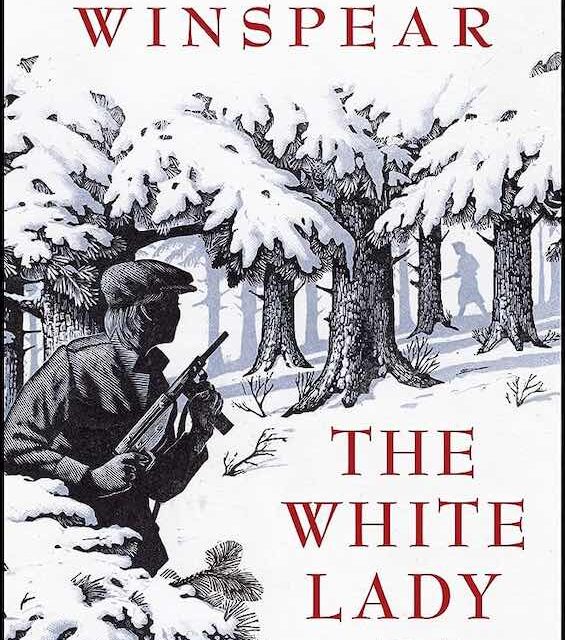
British American author Jacqueline Winspear has gained wide readership for the seventeen novels in her Maisie Dobbs series. The books follow the evolving career of a young woman raised in poverty in London through two world wars and the troubled times between. A nurse at the front in the first war, Maisie later becomes a private detective and builds a thriving practice. Then the second war threatens and leads her to work in espionage. Now, in The White Lady, a standalone historical thriller, Winspear introduces us to another remarkable heroine involved in espionage. She, too, follows a path through life deeply influenced by a tragic experience in World War I. And that path leads her to a mission behind Nazi lines in Britain’s Special Operations Executive.
Estimated reading time: 5 minutes
A title with four-fold meaning
Sometimes the people (often at the publishers) who craft book titles get clever and build double-meaning into the words. But Jacqueline Winspear has outdone them with The White Lady. Her heroine is Elinor White. The daughter of a British mother and a Belgian father, she grows up as Elinor De Witt. Which also means white. And when, after World War II she moves into the countryside in Kent, the people of her village call her “the White lady.” There, she tries in vain to escape the nightmares she still suffers over her experience in World War I in Belgium. There she went on missions as a girl in the resistance network called La Dame Blanche. And just in case the French words throw you, they mean “the white lady.”
The White Lady by Jacqueline Winspear (2023) 336 pages ★★★★★

A cleverly constructed standalone historical thriller
1916. Belgium. Elinor De Witt is twelve years old and her sister Cecily fifteen when a young woman named “Isabelle” approaches them and their mother with an invitation to help defeat the Germans occupying their country. The two girls are to bike toward the nearby railroad tracks and lay plates of steel across the tracks to derail a munitions train expected minutes later. And they eventually do this not once but twice. But the second time around, a year later, leads to tragedy—and nightmares that will haunt Elinor for decades.
1947. Village of Shacklehurst, Kent, England. Elinor White has been living for eighteen months in a “grace and favor” house gifted to her by the Crown for important service in World War II. She “keeps herself to herself,” as the British are wont to say—hiding out from her past. By choice, she has virtually no contact with her neighbors. But when a pretty three-year-old girl approaches her on a walk in the neighborhood, the veil is pierced. And later, when the little girl’s family is threatened by thugs from London, Elinor feels compelled to use her contacts in the government to help. Which leads her to carry a weapon once again—and to startling revelations about the secret life she led in the war.
Winspear shifts our attention back and forth from Elinor De Witt as a teenager to Elinor White in early middle age. Chapters alternate among the two wars, the time between, and the post-war era as Elinor finally comes to an understanding of the forces that have shaped her life.
The famous La Dame Blanche resistance network
During the final two years of World War I, three Belgian men organized a network that grew to include 1,000 agents to resist the German occupation. Some 300 of them were women. They operated not just in Belgium but eventually in northern France and Luxembourg, too. Although they became engaged in sabotage and other activities, their primary mission was to observe the German trains carrying troops, weaponrs, and munitions as well as traffic on major roads and activity at airfields and German military sites. Working in concert with British intelligence in the Netherlands, they supplied copious amounts of vital information. According to the International Encyclopedia of the First World War, “At the end of the war, the Allies knew with almost daily accuracy the details of German positions” as a result of the work of La Dame Blanche.
About the author

Jacqueline Winspear was born in 1955 in Kent, England (where this novel opens) but emigrated to the United States in 1990, where she has lived for many years. She is the author of the award-winning Maisie Dobbs series of seventeen historical novels and of a childhood memoir as well as this standalone historical thriller. Winspear was educated at the University of London’s Institute of Education. She worked for many years in academic publishing, higher education, and marketing communications.
For related reading
I’ve reviewed all the novels in the author’s award-winning detective series at The Maisie Dobbs novels from Jacqueline Winspear.
You might also care to check out:
- The 10 best novels about World War II
- 20 excellent standalone mysteries and thrillers
- 20 most enlightening historical novels
- Top 10 historical mysteries and thrillers
- Top 10 mystery and thriller series
And you can always find my most popular reviews, and the most recent ones, on the Home Page.



























